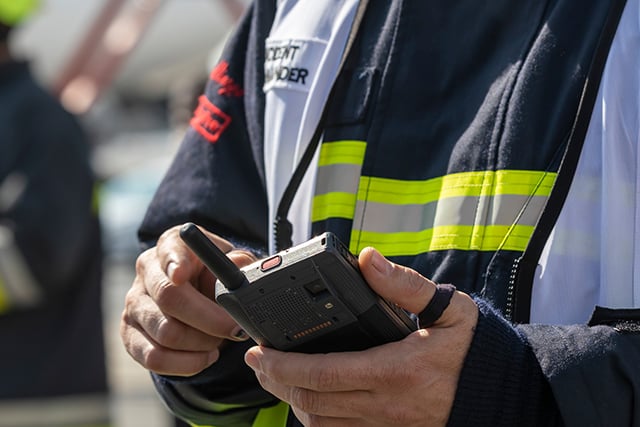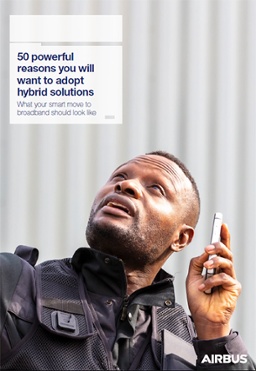What do organizations seek to achieve with hybrid networks? Over the last five years, visitors to the Airbus/SLC website have been asked this when they have expressed an interest for hybrid solutions and broadband evolution. Most of the respondents think that hybrid networks are a good idea for five reasons.
First, however, let’s take a look at the core concept – the hybrid network.
What is a hybrid network?
A hybrid network combines narrowband PMR and broadband LTE/4G/5G technologies. The technologies work together and deliver the benefits of both mission-critical communications and professional broadband apps.
Because the narrowband and broadband systems work in parallel, a hybrid network offers a smooth and lowest-risk transition towards full mission critical broadband. This way, broadband solutions can be adopted gradually – as an evolution, not as a revolution.
Why do people think hybrid networks are a good idea?
People were asked what they seek to achieve with hybrid networks. The more than 200 responses yielded clear trends, and the top five topics were:
In addition to the top 5 topics, there are 50 practical reasons to prefer hybrid solutions. Find out what they are: download “50 powerful reasons you will want to adopt hybrid solutions”.
Broadband evolution
More than 25 % of the respondents want their existing radio communication networks to go further. In a hybrid network, users can continue with their familiar, secure and reliable PMR voice and data. At the same time, they can start taking advantage of broadband services.
The hybrid model combines the best of both worlds. It is the reliable way to evolve the network while minimizing the risks. This also extends the lifetime of the already made investments in communications. Current operational processes can be maintained and new complementary capabilities can be introduced.

Narrowband PMR is ideal for voice communications, and there are data solutions built on short data messages and status messages. Broadband will complement this with its multimedia capabilities.
Handpicked related content
If your organization is thinking how to make a success of introducing broadband to complement the existing radio network, download this executive briefing "How to minimize risks when introducing mission-critical broadband". It explains why evolution to mission-critical broadband is the preferred option. It addresses public safety but its message applies to any professional organization.
Lower learning curve
Replacing professionals’ radios with smartphones would mean one technology replacing the other. People would experience a drastic shift from the familiar radio system to a new broadband network. The approach would not consider how they work.
Users need to have the skills to use their communication tools. This is all the more important when they need to work and communicate under pressure. When every second counts.

New tools require learning, and it’s easier to learn to use a new tool when it has something in common with the familiar one.
A hybrid network – and any hybrid solution worth its salt – builds on top of the existing ways of use. It does not force users to switch to a completely new technology and new operational processes.
Handpicked related content
When you are starting your learning path, plan your move to broadband with this comprehensive guide to hybrid solutions.
Interoperability
One in ten of the respondents mentioned interoperability or seamless communications.
Many public safety and other professionals are looking for a flexible way to enhance mission-critical communications with mobile broadband. They want seamless communications between the users of the current radio communication network and the LTE/4G/5G users.
In other words, team members need to be able to communicate together, using either a radio or a push-to-talk app on their smartphone.
It is natural to seek interoperability between the existing and the new system, but there’s more to interoperability than that.

True interoperability has been one of the drivers for developing today’s public safety networks based on TETRA, for example. Many organizations or businesses can share the use of the network and experience it as if it were their own private network. Because they share the same network, people can be connected smoothly and seamlessly if they need to work as a team.
Without true interoperability, organizations would return to the bad old days of siloed communications. In practice, they would lose much of their ability to work together.
Better security
One of the top five reasons for professionals to prefer hybrid networks is security.
Mission-critical broadband can improve efficiency and security for the user organizations. When user organizations have a hybrid solution from a Mission Critical Service Operator, they can remain in full control of subscribers and their confidential information.
Security is more than keeping communications controlled and confidential. Availability, for example, is an important part of communication security. Availability means that the system, its resources and applications are accessible when and where the user needs them. A hybrid network consists of two systems, so it can deliver better availability.
Another improvement to availability comes when a broadband network provides coverage for places where the radio network doesn’t reach, or vice versa. A hybrid solution will provide better coverage than either of the networks does separately.

Handpicked related content
Find out more about communication security in this blog post: “How to use 7 communication security strategies like the pros”.
Go a step beyond a hybrid consisting of two networks: choose a Mission Critical Service Operator who uses the services from more than one commercial Mobile Network Operator (MNO). You can achieve even better coverage, availability and reliability.
Critical organizations need total security for their professional communications. They need to be sure that all their devices follow security requirements. To keep data protected and available, devices cannot be compromised. After all, devices not complying with security policy are vulnerable to attack.
Handpicked related content
Want to be better prepared? Learn more about the security threats related to smartphones - download the white paper “How to manage smartphone risks for professional users”.
Lower cost
The final of the top reasons were lower costs and cost savings. People want their hybrid solutions to be economical.
When you already own a radio communications system, you can use your existing investment in the hybrid set-up. You will get completely new options at a fraction of the capital expenditure.
Is your organization building datacenters for your digital transformation? A hybrid solution can use that capacity for your broadband communication services.

The hybrid network is cost-effective, flexible and resilient when introducing mobile broadband services. Users can continue with their PMR network for mission-critical voice and data, and introduce mobile broadband services step-by-step.
A hybrid network lets you develop new ways of working while your existing operations go on as normal. Your users do not have to switch to a completely new technology, which would also be a huge risk to operations.
With a hybrid solution, you need only invest when you need to. You can even avoid capital investments completely if you choose a communication solution as a service.
Thanks to solutions like Tactilon Agnet, smartphone users can participate in group communication with TETRA radio users. And because smartphone users have the broadband connection, they can communicate even when outside TETRA network coverage.
The hybrid network in only one part of the equation
Simply replacing traditional radios by smart devices is not smart. It is not enough to replace the PTT key on the radio with an app in the smartphone. New technology needs to deliver more value than that. In fact, mission-critical mobile broadband has a much wider scope than push-to-talk, or even the core network.
Device-to-device communications, special coverage solutions like deployable bubbles, satellite connectivity, security and encryption solutions according to national requirements, and dispatching solutions – these are all part of the solution.
When moving to broadband, choose the lowest-risk choice. Download this eBook and you will know 50 reasons why hybrid solutions are the way to go:
Be smart: choose Airbus for your vendor and you will have a hybrid solution with all the elements, delivering an end-to-end service. Don’t miss your opportunities to embrace the power of hybrid solutions!






